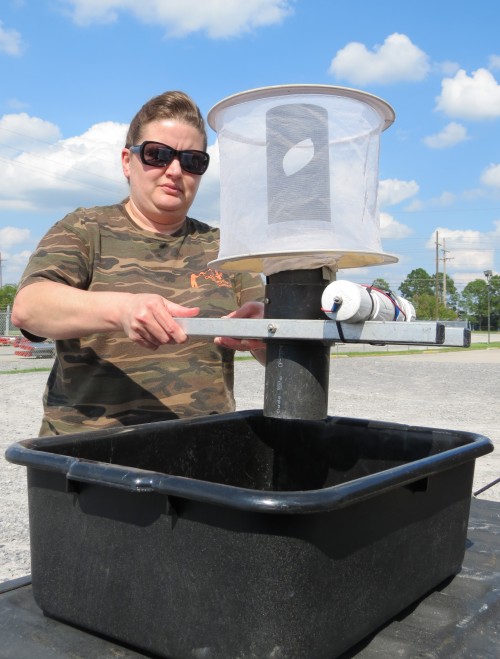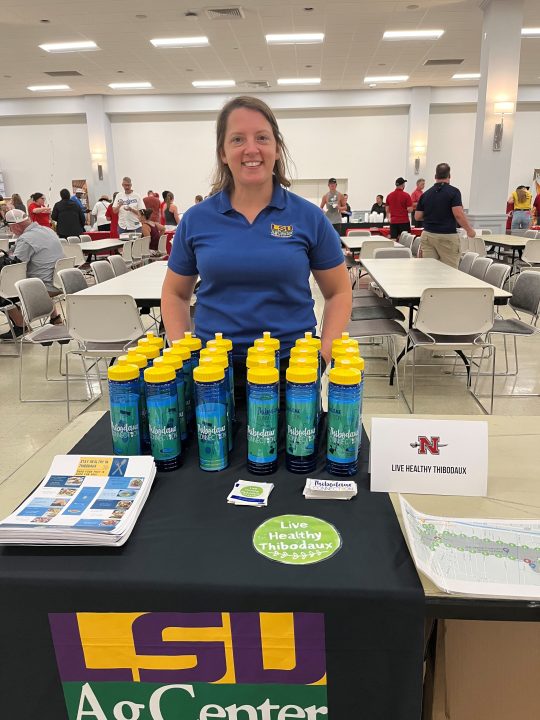
Bollinger receives federal funds for more cutters
October 2, 2012
Allen Augustin Hamilton
October 2, 2012Jessie Boudreaux is a third-generation Houma native who is concerned about family and community. That is why he made a career of eliminating pests – specifically mosquitoes.
The owner of Cajun Mosquito Control demonstrates there is more science and skill involved in his work than many people might think. It is not simply a matter of driving around in a truck with an attached fogger.
Having an interest in woodland creatures, particularly insects, might have offered Boudreaux a starting place in terms of taking on his chosen profession. However, it was when his young daughter became seriously ill because of a mosquito bite that he developed a passion to do something about it.
Boudreaux started with basic education and attended the University of Nebraska where he studied entomology. He then went to the University of New Orleans for business training, was licensed for commercial application of mosquito control in 1999 and for the past eight years has been leading his own operation by battling one the most dreaded creatures along the Gulf Coast.
“It took about five years to get my business plan finished,” Boudreaux said as he now services Terrebonne Parish, upper and lower St. Martin Parish and four municipalities in St. Mary Parish. In this business, it is more feasible to contract with government bodies and cover broad areas than attempt to address mosquito issues for individual residents.
On a typical job, Boudreaux and his crew first set traps to get an accurate reading of what variety of mosquitoes they are dealing with. They determine a general species population, estimate population levels and design a plan of attack.
Louisiana has documented 60 of the world’s more than 2,700 mosquito species. In Terrebonne Parish alone there are known to be 11 varieties of the pests. With a season that generally runs May through October, half a year is spent preparing for a battle the remaining six months. “This year it could go into November,” Boudreaux said.
Mosquito experts reveal that the idea of a hard freeze killing mosquito larva is a myth, making the insect’s determined existence as common as that of the wood roach.
“Testing helps you understand what species are present, what each species likes and does not like, and what time of day they will be out,” Boudreaux said. “Once you know their preferences, you can have an idea how to control them.”
One of the greatest concerns locally for mosquito control and health care professionals is West Nile virus. “It is very important to stay diligent,” he said. “We definitely want to remind people to avoid mosquitoes whenever possible.”
West Nile virus is a predominately mosquito-borne illness. Mosquitoes bite birds that carry the illness then bite people, spreading the infection to humans.
One form of West Nile virus can result in flu-like symptoms and rashes. The second manifestation is more severe and includes convulsions, paralysis and even comas.
As of Sept. 20, the U.S. Centers for Disease Control and Prevention had documented 3,142 cases of West Nile virus (31 in Louisiana), including 134 human deaths nationwide. Public health officials have said the summer of 2012 will be a record-setting season for West Nile with the highest number of incidents since 2003.
“The increased cases we are seeing this year are a firm reminder that West Nile virus is a serious disease, and people need to be vigilant about protecting themselves,” Louisiana Department of Health and Hospitals Epidemiologist Dr. Raoult Ratard said in a printed statement. “We know from 10 years of surveillance that this disease is active in every corner of the state, and people are at risk of getting it regardless of whether cases or deaths occurred in their parishes. Everyone should own their own health and take precautions against mosquito bites.”
Boudreaux said there could be a combination of factors behind this year’s high number of West Nile cases. “There could be immunity issues with humans,” he said. “There could have a different variation of birds that mosquitoes bit and transferred the virus to local birds. There are a number of things. The mild winter expedited the leading carrier of West Nile virus to high numbers in March and April.”
The Southern house mosquito is the primary pest that spreads West Nile virus and can go into a stage of inactivity, only to re-emerge and attack at a later date.
Boudreaux said fighting this and other mosquito species involves a step-by-step process. First, control experts work to obtain data on their ultimate target. For example, the Southern house mosquito will look for large containers or water-holding areas and sewage lines to breed. Traps are set to determine breeding areas.
“When they are in the juvenile or aquatic stage you need to treat them with a larvicide, which will kill them before they become airborne,” Boudreaux said. “We have hot spots mapped out where there is continual breeding, [usually] older subdivisions where they have septic issues.”
The No. 1 chemical used against mosquitoes in general is a suffocant. Different larva sizes, species and stages of development dictate what larva kill products should be used.
Suffocants create a light, oily sheen on water where mosquito larva exists. This prevents developing insects from getting needed air. Boudreaux said he can go through as much as 25 gallons of suffocants a day, but at other times only need a gallon or two depending on the situation and size of area being sprayed. According to mosquito experts, the last thing people should see is a spraying truck on the road, because of the number of steps taken before getting to the stage of needing blanket fogging of insecticides.
“We check out hot spots every week,” Boudreaux said. “It is part of our normal routine of checking traps, checking breeding and checking hot spots and determining what we need. It is not like grass killing. In order to have an insecticide you have to have insects there. So, you have to be very sure you are applying the right amount in an area that already has mosquito larva present. That is very important and it is regulated by the state.”
Boudreaux said that the most challenging part of this work is getting his message out to the public to be prepared and wear repellants. “They need to clear leaves, pick up branches and eliminate standing water,” he said.
This business owner considers it a blessing to provide a service to the community through his work.
“Our staff is one of our best assets,” Boudreaux said. “They are educated and dedicated to make sure people get what they are paying for. I’m glad to help anyway I can.”
Cajun Mosquito control employee Tisha Marcel demonstrates the usage of a gravib tab to help explain the science behind mosquito control. Knowing what species of mosquito one is dealing with is a first step toward establishing adequate control.










